Commercial microwaves have become indispensable in the foodservice industry due to their efficiency, reliability, and ability to handle high volumes of food.
Whether you run a bustling restaurant, a café, or a catering service, a larger microwave for commercial purpose can drastically cut down prep time, increase productivity, and ensure consistent quality.
They are specifically built for durability, high performance, and frequent use, unlike standard household microwaves.
However, selecting the right model requires careful consideration of your kitchen’s needs, the type of food you serve, and the volume of meals you prepare daily.
In this guide, we will dive deeper into the specifics of heavy-duty microwaves, their features, advantages, types, and important factors to consider when purchasing one.
We’ll also explore their common uses and why they are a game-changer in the fast-paced world of foodservice.

What is a Commercial Microwave?
It is a heavy-duty appliance designed to meet the high demands of professional kitchens.
Unlike residential models, which are used sporadically throughout the day, this heavy-duty appliances are built for frequent use, sometimes running continuously during peak hours.
These units come with more powerful wattages, typically ranging from 1,000 to over 3,000 watts, allowing for quicker cooking times and larger capacities.
Additionally, they are often constructed from more durable materials, like stainless steel, and feature user-friendly controls designed to simplify kitchen operations.
Key Features of Commercial Microwaves
1. High Power Output for Faster Cooking
The power output of this heavy-duty appliance is one of their key selling points.
With wattage levels typically between 1,000 and 3,000 watts, these microwaves can cook or reheat food significantly faster than residential models.
For example;
A microwave with 1,800 watts can reheat a meal in just 1-2 minutes, while a household microwave would take much longer.
This speed is crucial in professional kitchens where time is of the essence.
2. Sturdy and Durable Construction
It is designed with durability in mind.
Most models feature stainless steel exteriors and interiors that can withstand the rigors of a busy kitchen environment.
The heavy-duty construction ensures that these microwaves can endure continuous use without frequent breakdowns.
Furthermore, stainless steel interiors are easier to clean, maintain hygiene, and resist the wear and tear that comes with frequent use.
3. Simple Controls and Programmable Features
Efficiency in a commercial kitchen depends on ease of use, and they are built with this in mind.
Many models feature straight forward, easy-to-use controls that allow staff to select cooking times and power levels quickly.
Some models come with programmable settings, enabling staff to preset the microwave for specific tasks, such as defrosting or reheating, which reduces the chances of errors during busy service hours.
4. Consistent Cooking Performance
One of the biggest advantages of this appliance is their ability to cook food consistently.
Thanks to advanced heating technologies, these microwaves distribute heat evenly across dishes, ensuring food is properly cooked or reheated every time.
This is especially important in foodservice, where consistency in food quality can make or break customer satisfaction.
5. Larger Capacity for High-Volume Use
They are also available in various sizes to accommodate different kitchen needs.
Larger models have higher capacities, making it easier to prepare or reheat multiple portions of food at once.
This is particularly useful in high-demand environments, where large quantities of food need to be cooked quickly and consistently.
Editor’s Choice: List of oven you need to check out;
Supercharge Your Kitchen: Panasonic NE-1025F Compact Microwave Oven
Fast, Reliable, and Tough: Discover the Features of the AMANA RCS10TS Medium-Duty Microwave Oven
From Speed to Durability: How the AMANA RCS10DSE Microwave Oven Elevates Your Cooking
Boost Your Kitchen’s Efficiency with the AMANA RMS10DSA
AMANA RCS10MPSA: The Commercial Powerhouse
Benefits of Using a Commercial Microwave

1. Speed and Time Efficiency
One of the primary benefits is their speed.
In a busy restaurant or café, quick meal preparation is essential to maintain smooth service.
This oven cut down on cooking and reheating times, allowing kitchen staff to meet customer demands more effectively.
This speed not only enhances kitchen efficiency but also improves customer satisfaction by reducing wait times.
2. Energy Efficiency
They are known for their energy efficiency.
They consume significantly less electricity compared to traditional ovens, which need to preheat and cook food over longer periods.
Since microwaves operate quickly and do not require preheating, they save both time and energy, making them a cost-effective choice for foodservice establishments.
3. Space-Saving Design
Many commercial kitchens operate in compact spaces where every inch of counter space is valuable.
Commercial microwaves are compact yet powerful, providing a space-saving solution without compromising on performance.
Even larger models are more space-efficient than conventional ovens, freeing up valuable room for other kitchen equipment.
4. Versatility
They are incredibly versatile, capable of handling various cooking tasks such as reheating, defrosting, steaming, and even cooking certain dishes from scratch.
This versatility allows foodservice businesses to maximize their kitchen efficiency, as one appliance can perform multiple functions.
From heating soups and sauces to defrosting frozen ingredients, a commercial microwave can quickly adapt to the demands of the kitchen.
5. Safety Features
They are equipped with safety features to ensure secure operation.
Many models include automatic shut-off mechanisms that prevent overheating, child safety locks, and cool-touch exteriors to protect users from burns.
These safety features make commercial microwaves a reliable choice for fast-paced kitchen environments.
Types of Commercial Microwaves
Choosing the right type of commercial microwave depends on the specific needs of your business.
There are three primary categories of commercial microwaves: light-duty, medium-duty, and heavy-duty models.
1. Light-Duty Commercial Microwaves
Light-duty microwaves are the most basic option, designed for small foodservice establishments with lower volume needs.
These microwaves are typically rated around 1,000 watts and are ideal for reheating individual portions, warming up drinks, or defrosting small quantities of food.
Light-duty models are best suited for cafés, small offices, or convenience stores where microwave use is infrequent but necessary.
2. Medium-Duty Commercial Microwaves
Medium-duty microwaves are more powerful, with wattages ranging from 1,200 to 2,000 watts.
These microwaves can handle more frequent use and are ideal for small to medium-sized restaurants, fast-food outlets, or catering services.
They offer faster cooking times than light-duty models and can handle larger portions of food, making them more versatile in busy kitchen environments.
3. Heavy-Duty Commercial Microwaves
Heavy-duty microwaves are designed for high-volume kitchens where speed and durability are essential.
With wattages exceeding 2,000 watts, these microwaves can handle continuous use throughout the day without compromising performance.
Heavy-duty models are often found in large restaurants, hotels, hospitals, and institutional kitchens where multiple orders need to be processed quickly.
These units are built to withstand the highest level of wear and tear, making them the most durable option for commercial use.
Considerations When Buying a Commercial Microwave
When selecting a commercial microwave for your foodservice business, there are several key factors to consider to ensure you get the best appliance for your needs.
1. Wattage and Power
The wattage of a microwave determines its cooking speed and performance.
Higher wattage means faster cooking times, which is crucial in high-volume kitchens.
However, it’s important to choose a wattage that matches your specific needs.
A small café may not need a heavy-duty 3,000-watt microwave, while a large restaurant might benefit from the faster cooking times that higher wattage provides.
2. Size and Capacity
The size and capacity of the microwave should align with the volume of food your kitchen prepares.
If you’re reheating single portions or handling small tasks, a compact, light-duty microwave may suffice.
For larger batches or busier kitchens, a medium- or heavy-duty model with a larger interior will be more appropriate.
3. Ease of Use
Commercial kitchens often employ multiple staff members, so it’s important to choose a microwave that is user-friendly.
Look for models with intuitive controls and programmable settings that can be easily operated by all kitchen staff.
Simpler controls can speed up the cooking process and reduce the risk of errors during busy periods.
4. Durability and Build Quality
In a fast-paced kitchen environment, appliances need to be durable.
Stainless steel construction is the preferred choice for commercial microwaves due to its resilience and ease of cleaning.
Ensure the microwave you choose is built to last and can handle the wear and tear of daily use.
5. Ventilation Requirements
Ventilation is an important consideration, especially if the microwave will be placed in a small or enclosed space.
Proper ventilation prevents the microwave from overheating and ensures it operates efficiently.
Some heavy-duty models may require external ventilation systems, so be sure to check the manufacturer’s specifications.
Common Uses of Commercial Microwaves in Foodservice
- Reheating Pre-Cooked Meals: this is perfect for reheating pre-cooked dishes, soups, and sauces, ensuring quick service for customers.
- Defrosting Frozen Ingredients: with the ability to quickly defrost frozen meats, vegetables, and other ingredients, it saves valuable prep time.
- Steaming Vegetables: a lot of these heavy-duty appliance comes with steam cooking capabilities, making it easy to steam vegetables or seafood in a matter of minutes.
- Cooking Snacks or Small Dishes: From warming up breakfast sandwiches to cooking small portions of rice or pasta, commercial microwaves can handle light cooking tasks efficiently.
- Melting or Softening Ingredients: These microwaves are ideal for melting butter, chocolate, or softening ingredients like cream cheese for baking and cooking.
Conclusion: Why Invest in a Commercial Microwave?
In the fast-paced world of foodservice, a commercial microwave is an invaluable tool that offers speed, efficiency, and consistency.
Whether you run a small café or a large restaurant, investing in the right commercial microwave can significantly improve your kitchen’s operations and customer service.
By choosing a model that meets your needs, you can reduce prep times, increase productivity, and ensure that your kitchen runs smoothly during peak hours.
Whether it’s reheating, defrosting, or cooking, a commercial microwave is a versatile appliance that no professional kitchen should be without.